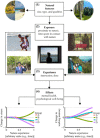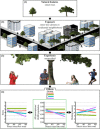Nature and mental health: An ecosystem service perspective
- PMID: 31355340
- PMCID: PMC6656547
- DOI: 10.1126/sciadv.aax0903
Nature and mental health: An ecosystem service perspective
Abstract
A growing body of empirical evidence is revealing the value of nature experience for mental health. With rapid urbanization and declines in human contact with nature globally, crucial decisions must be made about how to preserve and enhance opportunities for nature experience. Here, we first provide points of consensus across the natural, social, and health sciences on the impacts of nature experience on cognitive functioning, emotional well-being, and other dimensions of mental health. We then show how ecosystem service assessments can be expanded to include mental health, and provide a heuristic, conceptual model for doing so.
Figures



References
-
- G. C. Daily, Nature’s Services: Societal Dependence on Natural Ecosystems (Island Press, 1997).
-
- Millenium Ecosystem Assessment, Ecosystems and Human Well-Being (World Resources Institute, 2005).
-
- Díaz S., Pascual U., Stenseke M., Martin-López B., Watson R. T., Molnár Z., Hill R., Chan K. M. A., Baste I. A., Brauman K. A., Polasky S., Church A., Lonsdale M., Larigauderie A., Leadley P. W., van Oudenhoven A. P. E., van der Plaat F., Shröter M., Lavorel S., Aumeeruddy-Thomas Y., Bukvareva E., Davies K., Demissew S., Erpul G., Failler P., Guerra C. A., Hewitt C. L., Keune H., Lindley S., Shirayama Y., Assessing nature’s contributions to people. Science 359, 270–272 (2018). - PubMed
-
- Guerry A. D., Polasky S., Lubchenco J., Chaplin-Kramer R., Daily G. C., Griffin R., Ruckelshaus M., Bateman I. J., Duraiappah A., Elmqvist T., Feldman M. W., Folke C., Hoekstra J., Kareiva P. M., Keeler B. L., Li S., McKenzie E., Ouyang Z., Reyers B., Ricketts T. H., Rockström J., Tallis H., Vira B., Natural capital and ecosystem services informing decisions: From promise to practice. Proc. Natl. Acad. Sci. U.S.A. 112, 7348–7355 (2015). - PMC - PubMed
Publication types
MeSH terms
LinkOut - more resources
Full Text Sources
Medical

